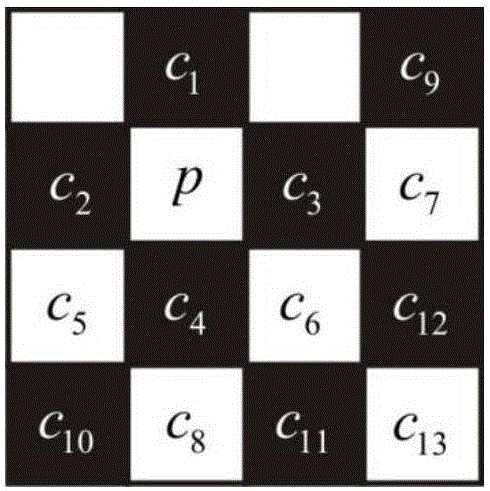High-fidelity reversible watermark embedding method
A technology of watermark embedding and embedding point, applied in image data processing, instrument, image data processing and other directions, can solve the problems of inability to accurately estimate p local complexity, large pixel embedding distortion, weak prediction performance, etc., and achieve good image quality. Redundancy, prediction error histogram concentration, improved embedding distortion
- Summary
- Abstract
- Description
- Claims
- Application Information
AI Technical Summary
Problems solved by technology
Method used
Image
Examples
Embodiment
[0045] The present invention is mainly composed of the following two parts: S1, watermark embedding process; S2, watermark extraction and original image restoration process. Wherein, the watermark embedding process includes the following steps:
[0046] S11. Image segmentation: Divide the pixels of a carrier image with a size of R×C into two non-overlapping pixel sets A and B, each pixel set contains pixels. The pixels belonging to the pixel set A are first embedded, and then the modified pixels in A are used to predict the pixels belonging to B, and the information is embedded in the pixels in B.
[0047] Here, the embedding process performed on pixels belonging to pixel set A or B is called one-layer embedding. The double-layer embedding guarantees the reversibility of the algorithm.
[0048] S12. Local correlation of pixels: For any pixel p in the pixel set A, the n (n∈{4,...,13}) pixels surrounding p constitute the neighborhood I of p ENP , and denote the pixel set I ...
PUM
 Login to View More
Login to View More Abstract
Description
Claims
Application Information
 Login to View More
Login to View More - R&D Engineer
- R&D Manager
- IP Professional
- Industry Leading Data Capabilities
- Powerful AI technology
- Patent DNA Extraction
Browse by: Latest US Patents, China's latest patents, Technical Efficacy Thesaurus, Application Domain, Technology Topic, Popular Technical Reports.
© 2024 PatSnap. All rights reserved.Legal|Privacy policy|Modern Slavery Act Transparency Statement|Sitemap|About US| Contact US: help@patsnap.com










